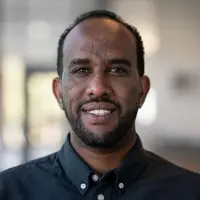
When most people think of Somalia, they immediately think about conflict. Or they think about insecurity. Or maybe hungry people.
But when I talk to the young people I work with throughout Somalia, that’s not what they see. They see hope – and potential.
To be sure, this East African nation continues to face many challenges. As it recovers from a decades-long civil war, Somalia is building its nascent governance structure while conflict continues in certain areas. The vacuum created by an absent or weak government over many years has resulted in poor infrastructure and fragile social systems—be they educational, health-related, or economic. Today, approximately 70 percent of Somalis live below the poverty line.
These challenges have hit Somalia’s youth particularly hard. More than 60 percent of the population is under the age of 25, and this group is consistently confronted with roadblocks to their economic success. Educational attainment is low—just 40 percent of children in Somalia attend primary school. The literacy rate for the total population stands at 37.8 percent. Vocational training systems are also weak. As a result, there are few young people who have the education and skills demanded by the current labor market; Somalia’s youth experience one of the highest unemployment rates in the world at 60 percent. When education and income-generating opportunities are unattainable, youth can turn to negative coping mechanisms such as illegal migration, engaging in organized crime, and even joining violent extremist groups.
The good news? Somali youth are some of the most motivated and resilient people I’ve ever met, even in the face of challenges. There is hope and potential in their future, thanks in no small part to continued partnership and investment from the United States Agency for International Development (USAID). In 2015, USAID launched a program aimed at revitalizing key sectors in Somalia’s economy and helping the country to re-enter the global market. The Somalia Growth, Enterprise, Employment and Livelihoods project—known as GEEL—has been working to help pave the way for a brighter future for Somalia’s workforce of tomorrow.
While one of the cornerstones of this program has always been youth empowerment, this week, USAID expanded GEEL to include a deeper focus on youth development and helping them to better prepare to become employees, employers, and entrepreneurs. Through GEEL, we’ll leverage these resources to expand opportunities for Somali youth in several ways:
- Introduce and expand new innovations and technologies in productive sectors such as agriculture and fisheries. We will create a network of Somali youth in agribusiness that will create and develop new innovations and technologies to produce products and services for the local agriculture market.
- Provide skills assessment and training for youth in critical areas such as literacy, numeracy, as well as technical areas like farming, food processing, or technology.
- Partner with the private sector, including Somali commercial banks, to make it easier for youth to become employees through increased networking opportunities and improving employers’ capabilities to select, train, and hire youth for job openings.
- Partner with Somali business service providers or incubators to provide business skills and services for Somali youth in business sectors.
- Increase high-demand skills in areas such as energy, in partnership with Somali energy and electricity companies.
- Increase access to financial services, such as business loans, for promising youth so they can expand entrepreneurship skills and capitalize on their talent.
With these and other planned interventions, we hope to help bring thousands of young people out of uncertainty and into labor market readiness while we strengthen Somali youths' entrepreneurial spirit.
Everywhere I go, I try to spread the message that there is more to Somalia than the negative news stories you may be used to seeing. Young people in Somalia are ready and willing to make positive contributions to their families, their communities, and their nation. We just need to give them the tools and opportunities to do so.

Somalia GEEL
Read more about how the USAID Somalia Growth, Enterprise, Employment and Livelihoods Project is working in key business sectors to stabilize Somali society.

